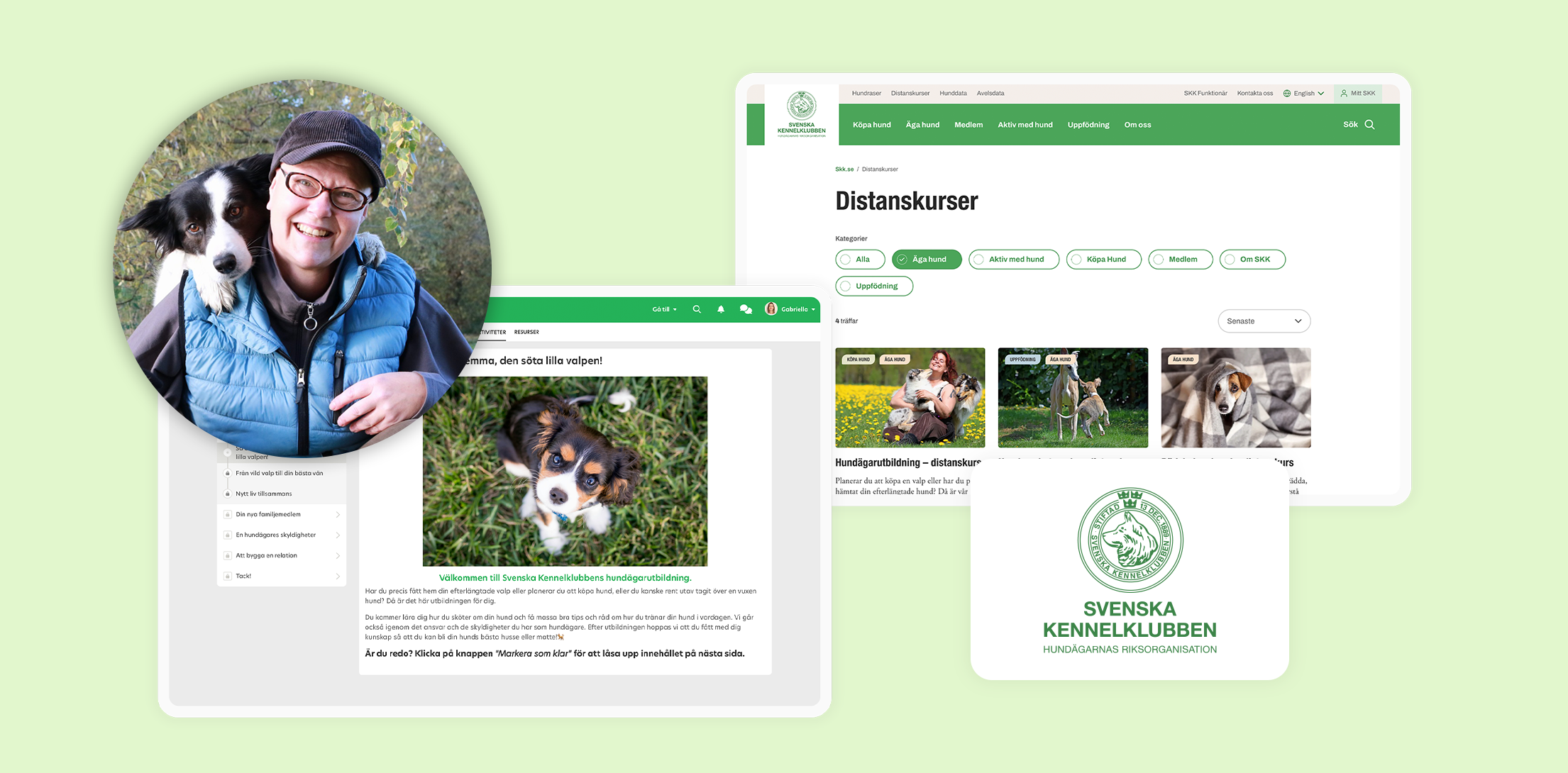The Swedish Kennel Club (Svenska Kennelklubben) is the national organization for dog owners, representing all dogs, dog owners, and dog lovers in Sweden. In recent years, they have embarked on an exciting journey in their educational activities. From offering traditional, in-person training, they have taken significant steps towards digitalization—something that became particularly appreciated during the pandemic.
We spoke with Nina Berggren, a training developer at the Swedish Kennel Club, who has worked in various forms of education for over 20 years. During our conversation, she shared how the Swedish Kennel Club adapted to new learning needs, both for its members, breeders, officials, and the general public, as well as the tools and platforms they use to reach a growing audience.

Nina Berggren, Training Developer at Swedish Kennel Club
The journey toward digital training
The Swedish Kennel Club has a long history of offering training to its members, especially for breeders and officials within the organization. They started experimenting with digital platforms early on, choosing a platform recommended by one of their elected representatives. Through this platform, they were able to offer extensive instructor-led distance learning courses.
During the pandemic, the demand for digital training from the Swedish Kennel Club skyrocketed. Like many other organizations, they faced the challenge of transitioning to distance education when in-person meetings were no longer possible. They quickly realized that this was a fantastic opportunity to reach more people, regardless of geographic location.
“During the pandemic, we really saw confirmation that our distance learning was appreciated. It gave our members something to do when other dog activities had to be canceled,” says Nina Berggren.
Further reading: Fun training saves lives – How Presto helps customers in the digital
The launch of Learnifier
In 2021, the Swedish Kennel Club took another step forward by introducing Learnifier as a new platform. Learnifier was easier to adapt for self-study courses and had a user-friendly interface, allowing SKK to offer both longer, more comprehensive courses and shorter self-study courses.
“Learnifier has a very simple and user-friendly setup, making it easy for us to create courses and offer both longer and shorter self-study courses to our members, breeders, officials, and the public”, says Nina Berggren.
One of the first courses they launched on Learnifier was the popular Dog Ownership Course, aimed at both members and non-members. By offering the course to the public, SKK hopes to spread important knowledge about dog ownership while also attracting more members. Another course that has garnered much attention is Fear in Dogs, which focuses on how to work with fears and anxiety in dogs to help them become more comfortable in various situations.
“It’s been crucial for us to be able to charge for the courses through an integration with Learnifier. With that, we can offer the courses widely. You just go through our webshop ‘My SKK’, click, pay for a course, and access it directly,” says Nina.
Further reading: How to create courses that deliver results

Specialized courses for professionals
In addition to courses aimed at dog owners, SKK has also developed more specialized training. An example is a course aimed at staff at veterinary clinics. The course covers how to take X-rays within SKK’s health program for elbow dysplasia (ED) and hip dysplasia (HD), something crucial for ensuring accurate reading of the X-rays. This course is not available to the general public but is specifically targeted at professionals in veterinary care.
"Learnifier has a very simple and user-friendly setup, making it easy for us to create courses and offer both longer and shorter self-study courses to our members, breeders, officials, and the public."
Challenges and successes
Although SKK has made great strides with their digital education, there are, as in all operations, challenges. A large part of the work involves coordinating educational material from different experts and adapting it to a digital environment. Some projects, like an X-ray course, are particularly complex and require precision to ensure that all information is accurate and accessible in an educational way. SKK has also worked hard to improve the process for how training is ordered and developed within the organization. By creating clear routines and processes, they’ve been able to prioritize projects in a more structured way, despite sometimes limited resources.
“It’s important that those who provide the expert knowledge give us the right materials so that we can package them in an educational way in Learnifier. Some projects are particularly complex and require careful collaboration to succeed,” says Nina.
Further reading: Creating a learning culture with Learnifier’s Mattias Borg

The future of SKK's training
Going forward, SKK plans to continue developing its digital education for its members, breeders, officials, and the general public. Nina Berggren also sees great potential in further developing the platforms they use to meet the needs of their various target groups. The digital transition has not only meant new ways of educating but also an opportunity to reach more people and spread knowledge about dog ownership in a more flexible and accessible way.
The Swedish Kennel Club is an excellent example of how an organization can adapt and grow by embracing digital opportunities. Thanks to their innovative thinking, dog owners across Sweden have gained access to valuable knowledge—whether they live in the north or south, or whether they are members or not. This is just the beginning of SKK’s journey in digital education, and we look forward to following their development in the future!
More than 320 companies and organizations currently work with Learnifier to easily and efficiently share knowledge, as well as create and administer courses, trainings, and training programs.
.png?width=153&height=58&name=Learnifier%20TextLogo%20NearBlack%20-%20PNG%20MEDIUM%20-%20800px%20(2).png)






